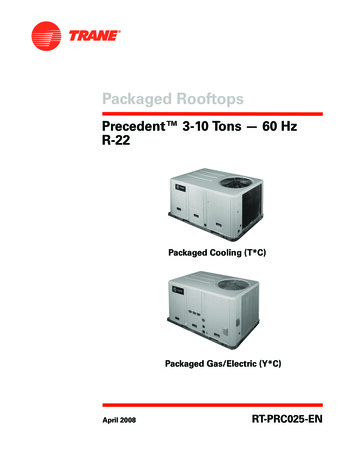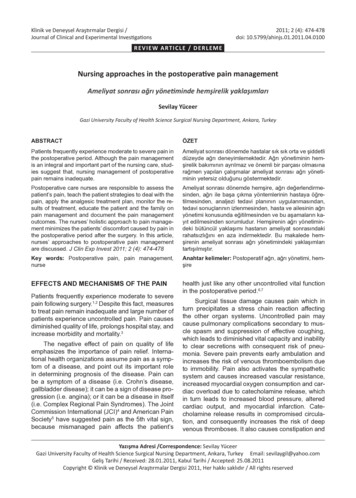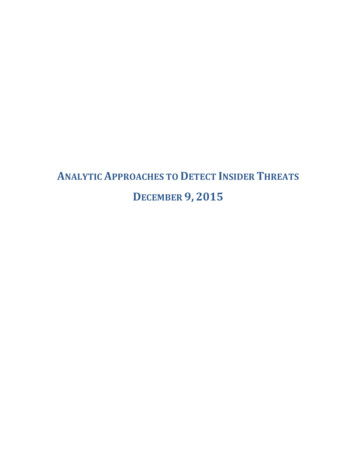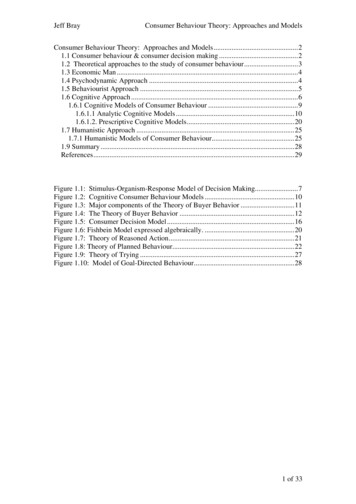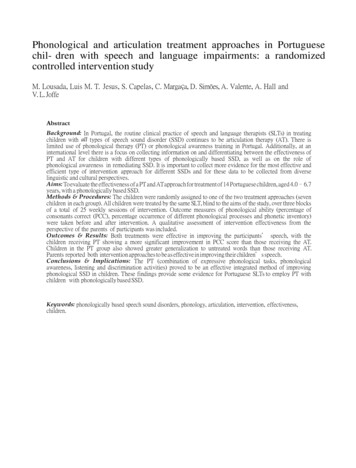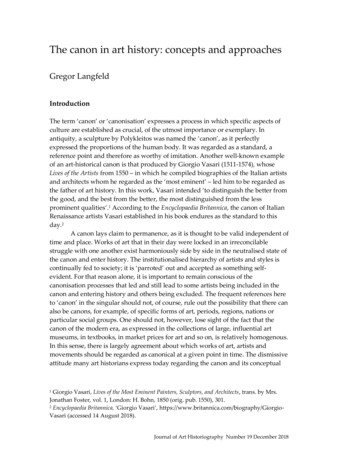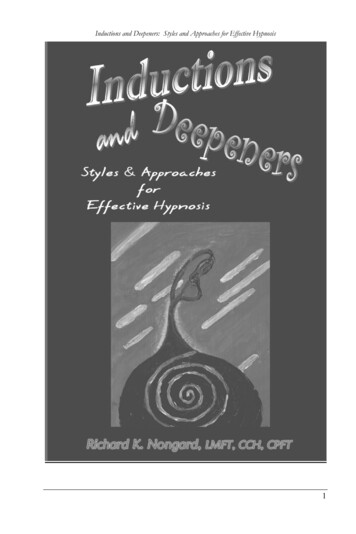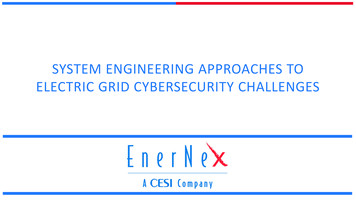
Transcription
SYSTEM ENGINEERING APPROACHES TOELECTRIC GRID CYBERSECURITY CHALLENGES 2019 EnerNex. All Rights Reserved. www.enernex.com
Webinar PresentersKay StefferudBrian SmithDirector of Implementation ServicesPrincipal Consultantkay@enernex.combsmith@enernex.com 2019 EnerNex. All Rights Reserved. www.enernex.com2
Agenda Topic 1: The Electric Grid - A Systems of Systems Topic 2: Cybersecurity Frameworks & Assessing and Qualifying Risk in OT Environments Topic 3: Developing OT Cybersecurity Architecture and Requirements Topic 4: Vulnerability Assessment and Testing Topic 5: Example Q&A 2019 EnerNex. All Rights Reserved. www.enernex.com3
TOPIC 1THE ELECTRIC GRID: A SYSTEM OF SYSTEMS 2019 EnerNex. All Rights Reserved. www.enernex.com4
Electric Grid System of Systems 2019 EnerNex. All Rights Reserved. www.enernex.com5
Electric Utilities General Overview Approximately 3100 electric utilities in the US Three Major Categories: Investor Owned Utility -IOU (approx. 200)Public Utilities Municipal - government or city-owned(approx. 2000)Rural or Co-operative (aka Co-ops) member-owned(approx. 900)148 million electric customers in the US200 Investor Owned Utilities (IOUs) such as SDG&E, serve most customersCyber attacks can target over 3100 separate electric utilities 2019 EnerNex. All Rights Reserved. www.enernex.com6
SCADA Control Systems Supervisory Control And Data Acquisition (SCADA) Control Many Grid DevicesUntil recently SCADAsystems wereisolated.Newer controlsystems are exposingSCADA systems tothe Internet. 2018 EnerNex All Rights Reserved 2019 EnerNex. All Rights Reserved. www.enernex.comIncreasing numbers ofcustomer ownedsolar Photovoltaic PV,electric vehicles andbattery storagesystems.7
Information Technology (IT) vs. Operational Technology (OT) Information Technology (IT) andOperational Technology (OT)systems face different threats Tools appropriate to use in ITenvironment may shut down orcompromise OT assets Restoring compromised systemsfrom backups poor fit for SCADAsystems as SCADA controlledhardware cannot simply be restored Long complex passwords for missioncritical system operators are aconcern 2019 EnerNex. All Rights Reserved. www.enernex.com8
Challenges for Electric UtilitiesExcerpts from “Cyber Threat and Vulnerability Analysis of the U.S. Electric Sector,”prepared by Idaho National Laboratory for the Office of Energy Policy and SystemsAnalysis (EPSA) in the U.S. Department of Energy Growth of networks and communication protocols used throughout control networks pose vulnerabilities that willcontinue to provide attack vectors that threat actors will seek to exploit for the foreseeable future. Theinteroperable technologies created for a shift toward a smart grid will continue to expand the cyber attacklandscape. Threat actors on multiple fronts continue to seek to exploit cyber vulnerabilities in the U.S. electrical grid. Nation-states like Russia, China, and Iran and non-state actors, including foreign terrorist and hacktivist groups, posevarying threats to the power grid. A determined, well-funded, capable threat actor with the appropriate attackvector can succeed to varying levels depending on what defenses are in place. Utilities often lack full scope perspective of their cyber security posture. Total awareness of all vulnerabilities andthreats at all times is improbable, but without enough cyber security staff and/or resources utilities often lack thecapabilities to identify cyber assets and fully comprehend system and network architectures necessary forconducting cyber security assessments, monitoring, and upgrades ” 2019 EnerNex. All Rights Reserved. www.enernex.com9
TOPIC 2CYBERSECURITY FRAMEWORKSASSESSING AND QUALIFYING RISK IN OPERATIONALTECHNOLOGY ENVIRONMENTS 2019 EnerNex. All Rights Reserved. www.enernex.com10
Cybersecurity Frameworks Examples Many cybersecurity frameworks available and often confusing where to start Risk Frameworks Identify, measure, and quantify risk Example: NIST SP800-30, SP800-37, SP800-39 Cybersecurity Program Frameworks Building a cybersecurity program Measuring maturity of a cybersecurity program Example: NIST Framework for Improving Critical Infrastructure Cybersecurity (CSF) Example: DOE Electric Sector Cybersecurity Capabilities Maturity Model (ES-C2M2) Cybersecurity Control & Requirements Frameworks Developing cybersecurity controls/requirements Examples: IEC-62443, NERC CIP, NISTIR 7628, NIST SP800-53, etc. 2019 EnerNex. All Rights Reserved. www.enernex.com11
Assessing Risk – Challenges in OT Environments The classic IT view of risk is not a good fit for the OT environment Utilizing a methodology derived largely from IT practice can be expensive, invasive, and notnecessarily cost-effective Most IT centric assessment methodologies tend to focus on identifying vulnerabilities and attackvectors Assessment methodologies in OT environments need to identify the operational, safety, andcompliance impacts Helps to prioritize expenditures 2019 EnerNex. All Rights Reserved. www.enernex.com12
Qualifying Risk - ExamplePrimary objective of a cyber assessment isto provide information necessary to manageidentified risks.Recommended approach is to base risk on: Safety Impacts Operational Impacts Compliance Impacts e.g.VSL(Violation Severity Level) 2019 EnerNex. All Rights Reserved. www.enernex.com13
TOPIC 3DEVELOPING OT CYBERSECURITYARCHITECTURE AND REQUIREMENTS 2019 EnerNex. All Rights Reserved. www.enernex.com14
Methodology – a Combination of Framework and Approach Two Key Elements of a Good Systems Engineering Methodology Framework – High level architecture guidance and/or catalog of cybersecurity controls Approach – How to apply the framework to your specific OT environment Needs are similar whether addressing the cybersecurity posture of exiting deployed systems ordeveloping architecture and requirements for new systems 2019 EnerNex. All Rights Reserved. www.enernex.com15
Utilize a Framework Best to utilize a structured framework when defining cybersecurity controls/requirements for OTsystems Lack of a structured methodology often results in gaps Many times cybersecurity controls/requirements defined ad hoc or brainstormed Highly dependent on the available resources and experience Not repeatable Need to address a wide variety of cybersecurity topics Example: NIST SP800-53 has 18 control families Need to have a balance of preventative, detective, corrective cybersecurity controls/requirements 2019 EnerNex. All Rights Reserved. www.enernex.com16
Select an Approach Now that you have selected a framework, you need an approach to utilize it Focus is on selecting or developing cybersecurity controls/requirements One option is to utilize a particular framework’s native approach Other methods can also be utilized based on available time and resources Top Down Approach Bottom Up/Basic Approach 2019 EnerNex. All Rights Reserved. www.enernex.com17
Top Down Approach Based on: System functionality, architecture, technology utilized May be resource intensive Mostly utilized when deploying new systems Vulnerability/Failure Analysis based on system functionality Possible attack vectors that may lead to identified failure modes Vulnerabilities that may be exploited to carry out these attacks Primary cybersecurity controls identified to address identified failure modes Example: ASAP-SG Security Profiles 2019 EnerNex. All Rights Reserved. www.enernex.com18
Example: Smart Meter Data FlowsSource: NESCOR Guide to Penetration Testing for Electric Utilities, Version 3 2019 EnerNex. All Rights Reserved. www.enernex.com19
Native Framework Approach Some frameworks provide a native approach for selecting cybersecurity controls Easier on resources A superset of industry experience and expertise Typically will not map one-to-one to any particular system Some elements do not apply to your specific system Cybersecurity controls/requirements determined by basic criteria/categorization Example: NISTIR 7628 - Guidelines for Smart Grid Cyber Security 2019 EnerNex. All Rights Reserved. www.enernex.com20
Bottom Up Approach Applies a standard set of cybersecuritycontrols/requirements to all systems Based on a set of known attack vectors Very little analysis of the underlyingsystem Good starting point Easiest on resources Example: The CIS Top 20 CriticalSecurity Controls 2019 EnerNex. All Rights Reserved. www.enernex.com21
Cybersecurity Control/Requirement Tailoring Regardless of framework and approach, some tailoring of the cybersecurity controls/requirementsis often needed Most frameworks and catalogs of security controls are generic IT language Need to customize to be specific to the OT environment (Underlying technology, functions, processes,etc.) Most frameworks and catalogs of security controls are relative to the "system" Need to be able to break things down to identify which components of the system that the securitycontrol/requirement applies Especially important if the effort is supporting procurement "System must be compliant to NERC CIP" is not a good requirement for a procurement specification 2019 EnerNex. All Rights Reserved. www.enernex.com22
TOPIC 4VULNERABILITY ASSESSMENTS AND TESTING 2019 EnerNex. All Rights Reserved. www.enernex.com23
Which Assessment Should You Use and When?Type of AssessmentITOT/SCADARecommendations QuarterlyMust be cautious in Control/SCADAenvironmentQuarterlyMay interrupt Control/SCADA environmentAnnually Major environment changes Major environment changesRed Team Assessment AnnuallyMay interrupt Control/SCADA environmentWhite/Grey/Black-boxAssessment AnnuallyMay interrupt Control/SCADA environmentApplication SecurityAssessment Major environment changes AnnuallyLimited to credit/debit card processing systemsAnnuallyLimited to healthcare/HR processing systemsAnnuallyLimited to financial data processing systemsAs requiredLimited to Control/SCADA environmentVulnerabilityAssessmentPenetration TestAuditRisk AssessmentThreat AssessmentPCI AssessmentHIPAA AssessmentSoX AssessmentNERC CIP 2019 EnerNex. All Rights Reserved. www.enernex.comLevel of Riskof PotentialImpact toEnvironmentLowMediumHigh24
Requirements Review Document North American Electric Reliability Corporation (NERC) Critical Infrastructure Protection(CIP) requirements Determine if requirements are defined relative to system functionality and aligned with theorganization’s security goals and objectives Determine if requirements are mapped to specific solutions deployed to meet requirements Map cybersecurity requirements to systems Include cybersecurity requirements in all procurement specifications and RFPs Identify potential gaps Incomplete or missing requirements Controls (verification methods) not present, weak, untestable, etc. 2019 EnerNex. All Rights Reserved. www.enernex.com25
Architecture Review Network architecture review evaluates the functionand placement of network components Security perimeters, segregation, and separation Access points Information flows Dependencies Resiliency Can be used to help drive common cyber enterprisearchitecture Ideally assists with acquiring stakeholder support acrossIT and operational groups 2019 EnerNex. All Rights Reserved. www.enernex.com26
Overview of Security Penetration Test Many ways to perform a pen test depending on scope and environmentCyber testing focuses onsystem and componentcommunications interfaces.In addition to penetrationtesting, testing is typicallyperformed to assess insiderthreats including users withelevated access levels. 2019 EnerNex. All Rights Reserved. www.enernex.com27
DOE Electricity Subsector Cybersecurity Capability Maturity Model (ES-C2M2)Electricity Subsector Cyber Security Capability Maturity Model (CMM)Goal of anassessment is toassess anorganization'ssecurity postureand preparednessto deal withcyber attacks andbreaches.Like otherCMMs,workshops andquestionnairesare used to scoreorganization’smaturity level. 2019 EnerNex. All Rights Reserved. www.enernex.com28
North American Electric Reliability Corporation (NERC) Critical Infrastructure Protection (CIP)NERC CIP requirements designed to secure North America's bulk electric system (BES)CIP-002-5.1a Cyber Security - BES Cyber System CategorizationCIP-003-6 Cyber Security - Security Management ControlsCIP-004-6 Cyber Security - Personnel & TrainingCIP-005-5 Cyber Security - Electronic Security Perimeter(s)CIP-006-6 Cyber Security - Physical Security of BES Cyber SystemsCIP-007-6 Cyber Security - System Security ManagementCIP-008-5 Cyber Security - Incident Reporting and Response PlanningCIP-009-6 Cyber Security - Recovery Plans for BES Cyber SystemsCIP-010-2 Cyber Security - Configuration Change Management andCIP-011-2CIP-013-1CIP-014-2Vulnerability AssessmentsCyber Security - Information ProtectionCyber Security - Supply Chain Risk ManagementPhysical SecurityRecommended System Engineering ApproachDocument & map each NERC CIPrequirement to: Applicable systems Acceptable evidence types(measures) Responsible organizations Responsible persons with contactinformation Title of evidence Location of evidence Link to evidence 2019 EnerNex. All Rights Reserved. www.enernex.com29
TOPIC 5EXAMPLE 2019 EnerNex. All Rights Reserved. www.enernex.com30
Example: Systems Engineering Approach to Security from National Renewable Energy Resources Lab (NREL)NREL 10 Step System Engineering Cyber Security Approach NREL System EngineeringCyber Security Activities 1.2.3.4.5. IdentifyProtectMonitorRespondRecover Assess cyber-governance (security controls in place, prioritized action items for gaps insecurity controls) (identify and protect)Implement technical plan to address gaps from cyber-governance assessment (protect)Perform due diligence on cutting-edge cybersecurity technologies for energy systems,including functional and integration testing (identify and protect)Develop procurement language for secure, reliable, and resilient SCADA systems (protect)Review SCADA cybersecurity architecture and benchmark against NREL's nine-layercybersecurity model, including vulnerability assessment and risk mitigation (identify,protect, monitor, and respond)Scan software code and binary executables to identify malware and cyber risks as well astechniques for mitigation (identify and protect)Test data fuzz of SCADA systems with risk mitigations (identify and protect)Pen-test SCADA systems to identify residual cyber risks and provide mitigations (monitor,respond, and recover)Develop and analyze failure scenarios with mitigations (recover)Provide training on cybersecurity awareness for corporate staff and informationtechnology/operation technology audiences to reduce cyber risks from social engineeringand phishing schemes from advanced persistent threats (all)Source: -10-step.html 2019 EnerNex. All Rights Reserved. www.enernex.com31
Summary Improve cybersecurity using system engineering techniques Requirements Ensure cybersecurity requirements e.g. NERC CIP are documented Include consistent cybersecurity requirements in all RFPs Develop cybersecurity use cases Enterprise Architecture Use standard electric grid industry reference architectures e.g. NIST Coordinate IT and OT architectures into integrated enterprisearchitecture Recognize IT and OT cyber systems face differ threats and needdifferent cybersecurity solutions Actively test cybersecurity requirementsVulnerability/threat/failure analyses Leverage requirements, enterprise architecture and testing artifacts 2019 EnerNex. All Rights Reserved. www.enernex.com32
Q&AAt this time, please submit your questions for the presenters in the chat box.The slides from today, along with on-demand access to this presentation, will be emailed within 24hours of the close of this webinar. 2019 EnerNex. All Rights Reserved. www.enernex.com33
Contact InformationKay StefferudBrian SmithDirector of Implementation ServicesPrincipal Consultantkay@enernex.combsmith@enernex.com 2019 EnerNex. All Rights Reserved. www.enernex.com34
THANK YOU!Connect with Usenernex.comcesi.it 2019 EnerNex. All Rights Reserved. www.enernex.com
Jul 20, 2019 · Source: NESCOR Guide to Penetration Testing for Electric Utilities, Version 3 . Audit Annually Risk Assessment Major environment changes Threat Assessment . Perform due diligence on cu
